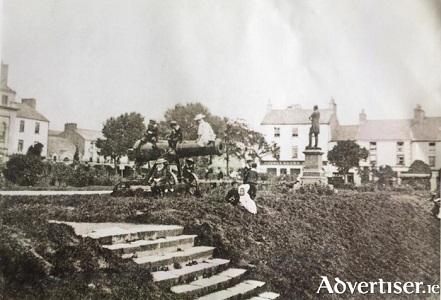The Guns in the Square

by Tom Kenny
The Galway Vindicator of July 25, 1857, reported the arrival in Galway on board the SS Lady Eglinton, of two cannon, which had been shipped from Woolwich Arsenal, the main storage and distribution depot of Crimean War ordnance. These cannon, described as “64-pounders of a heavy and clumsy description, each weighing two tons,” were taken from the docks to the goods yard beside the railway station, where they were made ready for the handing over ceremony. They were part of a significant amount of Russian ordnance which had been captured in 1854 by the 88th Regiment at the Battle of Inkerman during the Crimean War. They were two of a number of artillery pieces that were presented by the war department to various cities as trophies.
On Monday, August 3, 1857, the presentation of the “Sebastapol trophies” took place in pouring rain at midday. They were mounted on iron carriages and escorted from the goods yard around to the front of the Railway Hotel where special plinths had been prepared on either side of the front door. The procession was led by Peter Sarsfield Comyn, High Sheriff, who had been responsible for their safe arrival, and indeed had underwritten the cost of transportation. The guns were run up the steps on ramps and faced outwards towards a sodden crowd consisting of the "fashionable" people of the town, businessmen, and gentry from the county. The speeches got under way in the torrential rain but it was obvious they would have to be abandoned and as the Vindicator put it, “Sauve qui peut was, if not the general cry, the general feeling, and all beat a hasty retreat with as much precipitation as the Russians themselves when the guns were captured”. They all adjourned to the Town Hall for refreshments and entertainment which continued into the small hours of the following day.
The rise of Fenianism in the 1860s unnerved the authorities and they removed the guns in case the revolutionaries might be able to make them serviceable. Most people thought this was ridiculous, the Fenians would be incapable of using such heavy artillery, but they were removed. They were an attractive ornament to the town and were badly missed. On the last day of 1868, they were returned to the northern end of the Square.
As you can see from our photograph, which was taken c1890, these guns were a major attraction in the Square, particularly with children who were always playing around them. The second cannon can be seen on the far right of the photograph. The statue between them was by John Henry Foley and the subject was Lord Dunkellin, a most unpopular landlord. After the truce was signed, a mob gathered and pulled down this statue. It was dragged, accompanied by marching bands and great celebrations, along the street and dumped into the river.
Monuments don’t do very well in Eyre Square, the Browne Doorway is a disgrace, the fountain is no longer a fountain, the JFK monument was vandalised, Pádraic Ó Conaire was beheaded, and these cannon were moved some years ago during the ‘improving’ of the Square. They are still on public view but I bet a lot of Galwegians don’t know where.
Most of the above is taken from a fascinating article by Tim Collins in the Galway Archaeological and Historical Journal, Volume 48, which was published in 1996.
.png)